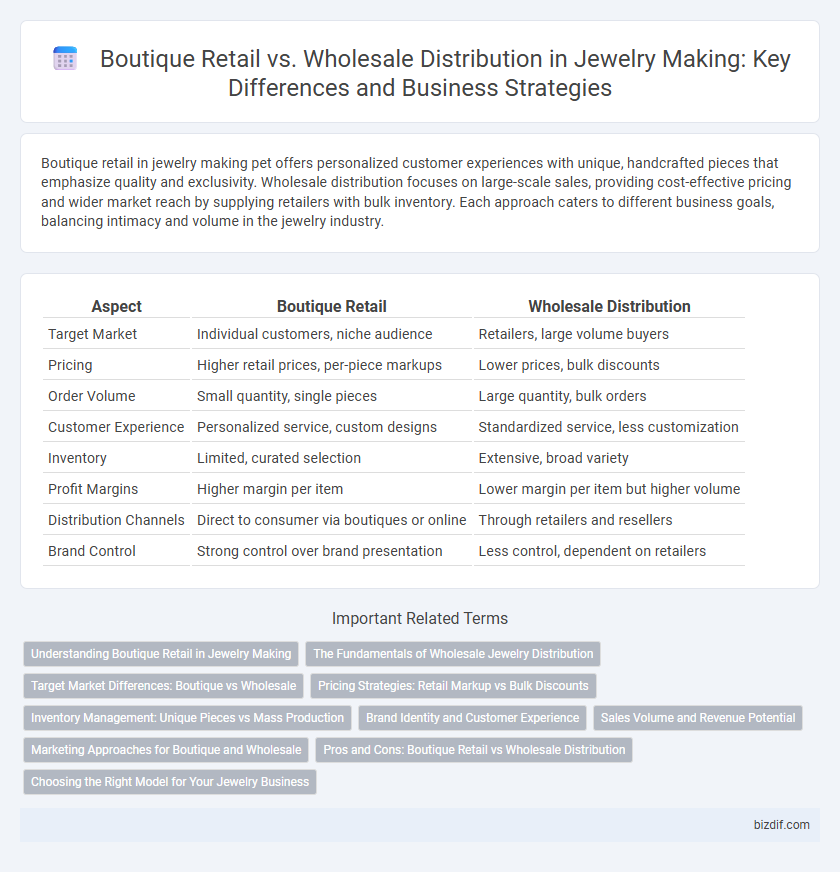Boutique retail in jewelry making pet offers personalized customer experiences with unique, handcrafted pieces that emphasize quality and exclusivity. Wholesale distribution focuses on large-scale sales, providing cost-effective pricing and wider market reach by supplying retailers with bulk inventory. Each approach caters to different business goals, balancing intimacy and volume in the jewelry industry.
Table of Comparison
| Aspect | Boutique Retail | Wholesale Distribution |
|---|---|---|
| Target Market | Individual customers, niche audience | Retailers, large volume buyers |
| Pricing | Higher retail prices, per-piece markups | Lower prices, bulk discounts |
| Order Volume | Small quantity, single pieces | Large quantity, bulk orders |
| Customer Experience | Personalized service, custom designs | Standardized service, less customization |
| Inventory | Limited, curated selection | Extensive, broad variety |
| Profit Margins | Higher margin per item | Lower margin per item but higher volume |
| Distribution Channels | Direct to consumer via boutiques or online | Through retailers and resellers |
| Brand Control | Strong control over brand presentation | Less control, dependent on retailers |
Understanding Boutique Retail in Jewelry Making
Boutique retail in jewelry making emphasizes unique, handcrafted pieces that showcase artisanal skill and creativity, appealing to discerning customers seeking exclusivity. This approach allows jewelers to establish strong brand identity and personalized customer experiences, which often justifies higher price points. Unlike wholesale distribution, boutique retail prioritizes direct engagement and limited inventory to maintain craftsmanship integrity and luxury appeal.
The Fundamentals of Wholesale Jewelry Distribution
Wholesale jewelry distribution centers on bulk supply from manufacturers to retailers, offering cost advantages and consistent inventory for boutique stores. Understanding pricing structures, minimum order quantities, and supplier relationships is crucial for effective wholesale operations. Efficient distribution networks ensure timely delivery and maintain the integrity of high-quality gemstones and metals essential in jewelry making.
Target Market Differences: Boutique vs Wholesale
Boutique retail in jewelry making targets niche markets seeking unique, handcrafted pieces often characterized by exclusivity and higher price points. Wholesale distribution focuses on mass-market retailers and businesses requiring bulk purchases at lower price margins, emphasizing quantity over individuality. Understanding these distinctions enables jewelers to tailor their designs, marketing strategies, and pricing models to align with customer expectations and maximize sales potential.
Pricing Strategies: Retail Markup vs Bulk Discounts
Boutique retail pricing in jewelry making typically involves higher retail markups, often ranging from 100% to 300%, to cover personalized service, unique designs, and lower volume sales, ensuring premium profit margins per piece. Wholesale distribution relies on bulk discounts, with prices reduced by 20% to 50% depending on order volume, appealing to buyers looking for cost efficiency and larger inventory acquisition. Understanding these contrasting pricing strategies helps jewelers optimize revenue streams by balancing exclusive retail pricing with competitive wholesale offers.
Inventory Management: Unique Pieces vs Mass Production
Boutique retail in jewelry making emphasizes inventory management of unique, handcrafted pieces, requiring precise tracking and limited stock to maintain exclusivity. Wholesale distribution focuses on mass production inventory systems, handling large quantities of standardized items to ensure consistent supply across multiple retailers. Efficient inventory software tailored to each approach optimizes stock levels, reduces carrying costs, and supports demand forecasting specific to either bespoke or bulk market strategies.
Brand Identity and Customer Experience
Boutique retail in jewelry making emphasizes personalized brand identity through curated collections and intimate customer interactions, fostering strong emotional connections and exclusivity. Wholesale distribution prioritizes volume sales with broader market reach, often sacrificing individualized customer experience for efficiency and scalability. The choice between boutique and wholesale profoundly impacts how a jewelry brand communicates its uniqueness and engages with its audience.
Sales Volume and Revenue Potential
Boutique retail in jewelry making emphasizes curated collections with higher profit margins per piece, attracting discerning customers willing to pay premium prices, resulting in moderate sales volume but substantial revenue potential. Wholesale distribution targets larger sales volumes by supplying bulk orders to multiple retailers, generating lower margins per unit but achieving significant overall revenue through scale. Strategic balancing between boutique exclusivity and wholesale reach can optimize both sales volume and revenue growth within the jewelry market.
Marketing Approaches for Boutique and Wholesale
Boutique retail marketing in jewelry making emphasizes personalized customer experiences, exclusive collections, and storytelling that highlights craftsmanship and uniqueness to attract discerning buyers. Wholesale distribution strategies prioritize broad market reach, competitive pricing, and efficient supply chain management to build relationships with retailers and bulk purchasers. Both approaches require tailored branding and targeted promotions to optimize sales channels and enhance brand visibility in the jewelry market.
Pros and Cons: Boutique Retail vs Wholesale Distribution
Boutique retail offers personalized customer experiences and higher profit margins per piece, ideal for unique or custom-made jewelry, but it demands greater marketing efforts and inventory risk. Wholesale distribution enables large-volume sales and broader market reach, reducing per-unit costs, though it often results in lower profit margins and less brand control. Choosing between boutique retail and wholesale depends on balancing scalability with brand exclusivity and customer engagement.
Choosing the Right Model for Your Jewelry Business
Selecting the ideal business model for jewelry involves weighing boutique retail's personalized customer experience against wholesale distribution's broader market reach. Boutique retail offers higher profit margins and brand exclusivity, while wholesale distribution emphasizes volume sales and rapid inventory turnover. Understanding target audience preferences and operational capacity is crucial for aligning with the most profitable and sustainable approach in jewelry making.
Boutique retail vs Wholesale distribution Infographic

 bizdif.com
bizdif.com